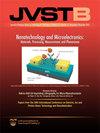Nanometer-scale capillary-driven flow and molecular weight govern polymer nanostructure deposition from a heated tip
IF 1.4
4区 工程技术
引用次数: 0
Abstract
This paper investigates the physical process of polymer nanostructure deposition from a heated atomic force microscope (AFM) tip and focuses on the role of capillary-driven flow on deposited feature sizes during thermal dip-pen nanolithography. We used a heated AFM tip to deposit 50–350 nm wide poly(methyl methacrylate) nanoribbons by varying tip temperature, tip speed, and polymer molecular weight. For polymers of different molecular weights, the width of the deposited polymer nanoribbons decreases with capillary number (Ca), independent of tip temperature, tip speed, and polymer molecular weight. These results indicate that the capillary-driven flow governs polymer nanostructure deposition from a heated tip. For high molecular weight polymers deposited with feature size close to the polymer radius of gyration Rg, the molecular weight also influences the size of the deposited polymer ribbon. Using scaling arguments, we show that the feature size can be predicted by Ca and Rg. Uniform and continuous deposition occurs only when Ca << 1, confirming that the polymer flow is driven by the capillary force. The results of this study enable better control of speed and resolution at which polymer nanostructures can be fabricated using AFM.纳米级毛细管驱动的流动和分子量决定了聚合物纳米结构在加热尖端的沉积
本文在原子力显微镜(AFM)尖端研究了聚合物纳米结构沉积的物理过程,重点研究了热浸笔纳米光刻过程中毛细管驱动的流动对沉积特征尺寸的影响。我们使用加热的AFM尖端,通过改变尖端温度、尖端速度和聚合物分子量来沉积50 - 350nm宽的聚甲基丙烯酸甲酯纳米带。对于不同分子量的聚合物,沉积的聚合物纳米带宽度随毛细数(Ca)而减小,与尖端温度、尖端速度和聚合物分子量无关。这些结果表明,毛细管驱动的流动控制着聚合物纳米结构在加热尖端的沉积。对于特征尺寸接近聚合物旋转半径Rg的高分子量聚合物,分子量也会影响沉积聚合物带的尺寸。使用缩放参数,我们证明了Ca和Rg可以预测特征大小。只有当Ca << 1时才会出现均匀连续的沉积,证实聚合物流动是由毛细力驱动的。本研究的结果可以更好地控制速度和分辨率,聚合物纳米结构可以用原子力显微镜制造。
本文章由计算机程序翻译,如有差异,请以英文原文为准。
求助全文
约1分钟内获得全文
求助全文
来源期刊

Journal of Vacuum Science & Technology B
工程技术-工程:电子与电气
自引率
14.30%
发文量
0
审稿时长
2.5 months
期刊介绍:
Journal of Vacuum Science & Technology B emphasizes processing, measurement and phenomena associated with micrometer and nanometer structures and devices. Processing may include vacuum processing, plasma processing and microlithography among others, while measurement refers to a wide range of materials and device characterization methods for understanding the physics and chemistry of submicron and nanometer structures and devices.
 求助内容:
求助内容: 应助结果提醒方式:
应助结果提醒方式:


